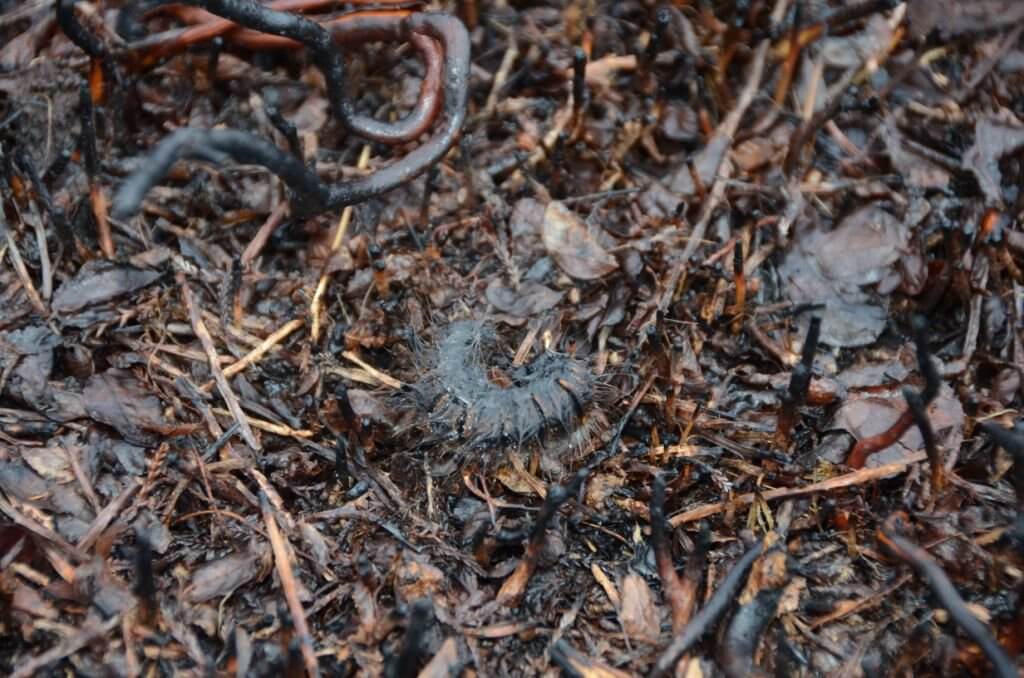
Here’s an example of wildlife benefitting from moorland burning (which is done to produce unnaturally high densities of Red Grouse for shooting for fun). Can anyone identify this scorched caterpillar please? The best guesses so far are Northern Eggar (but perhaps Fox Moth). Help me out please if you are an expert on barbecued wildlife.
The Northern Eggar is a pretty common species but this image illustrates the point that many invertebrate species are vulnerable to intensive burning of the type required for driven grouse shooting. Tell them that this was a cool burn!
As you can see this invertebrate has benefitted hugely from the intense management of this land, subsidised by the taxpayer, for grouse shooting.
Burning of this sort is legal in the uplands of England until 15 April in upland areas. This seems incredibly late in the year to me. With the earlier nesting of many birds due to climate change there must be an argument for curtailing burning much earlier – after all, proper farmers are expected to cease hedge-cutting at the very beginning of March.
I keep hearing that Common Lizards, Common Frogs and snakes, particularly Adders, are also vulnerable to spring burns. This seems very likely – has anyone done any research on the subject?
The idea that torching the uplands for the benefit of one quarry species, Red Grouse, and a few of another species (humans), at the expense of many other species and many other people stands, but not very firmly, as a monument to outmoded land uses for the benefit of the few and the disbenefit of the many.
 PS I know that Natural England gets very twitchy and nervous when this blog starts posting about the upland environment, with photographs, so I thought I’d just say that this is the last post on the subject today. But maybe a compilation blog post will soon be in order.
PS I know that Natural England gets very twitchy and nervous when this blog starts posting about the upland environment, with photographs, so I thought I’d just say that this is the last post on the subject today. But maybe a compilation blog post will soon be in order.
[registration_form]
If you are making NE twitchy then don’t stop, post more.
Is there any way to get hold of someone with a drone and fly it over moors when burns (or culls) take place? Amp that twitchyness up to 11.
Drinker or Fox Moth i think.
Actually pretty sure it is a Fox Moth.
Fox Moth (or what’s left of it) would be my guess
If NE are twitchy it is because they are no longer the organisation that helps manage the natural environment for the benefit of wildlife and the environment but, like so many “environmental consultancies”, is merely there to rubber stamp government decisions and commercial exploitation. Wildlife and environmental protection come a long way down their list of priorities.
Spot on, Simon. Full agreement here. Making NE twitchy ought to be a good thing, let them know that they cannot be complacent in their rubber stamping and forelock tugging.
Probably Fox moth var carbonaria
At least the nice people on Walshaw moor have given their frogs a choice.
They can either roast alive or dive into one of the new super butts that are level with the ground and die trying to get out.
Not much of a choice I grant, but more than the caterpillar had.
Don’t forget the frogs. NE, that’s you I’m talking to.
It looks like a barbecued Fox Moth caterpillar. Or rather what I imagine a barbecued Fox Moth caterpillar must look like.
Burning must kill huge amounts of invertebrates and reptiles. Simply because the areas burned are full of these species and they certainly won’t be capable of escaping in time.
I take it that it’s the senior management of NE, which gets twitchy at these articles.
Maybe a ‘Grouse Moor Wildlife ID’ book could be produced – buzzard mangled in pole trap, harriers and eagles contorted with carbofuran poisoning, squashed weasels and stoat in tunnel traps, snared fox, belly up trout in acid beck and incinerated juniper, adder, caterpillar etc? Oh yeah and diseased grouse, and shot mountain hare in back of pick up.
There is a joint NE & ARC Trust report on the assessment of the impact of controlled burning on reptile populations in lowlands: http://nora.nerc.ac.uk/20507/1/N020507CR.pdf
Executive summary says that ‘given the known habitat requirements of the six native species of reptile occurring on lowland heathland, in the UK, the clear conclusion of this review is that fire destroys reptile habitat and is likely to result in significant mortality to the animals present in burnt areas.’…
Whilst this study focused on the lowlands (where there are different species and land management), it highlights vulnerability of reptiles to burning…
Thank you, SG, for the link.
I suppose this gov/DEFRA/NE need to have the science put before them (to ignore, it would seem) – but doesn’t common sense tell most people what are the results of burning the land?
If any one of these august bodies is ‘twitchy’ – let them get off their backsides and do something about this cruelty – because that’s what it is.
I’m fed up with all this toff knocking. This is clearly an exercise in forced natural selection. In time there will be new breeds that can run and fly faster to get away from the flames, and the local economy will benefit immensely. Well done to the landed gentry I say. Very public spirited.
I now have an image of a herd of Caterpillars galloping across the moor to avoid the flames!
The Small Lappet moth Phyllodesma ilicifolia is considered extinct in the UK. Roy Leverton, writing in Atropos (2016; vol 56 pp 4- 9) suggested that its disappearance from the moors of northern England in the 19th century may have been due to the rise of driven grouse shooting. This moth prefers to lay its eggs on the older growth heather and bilberry which would have always tended to be the next in line for burning in the muirburn cycle, meaning that a large proportion each season’s young would have been barbecued.
Whilst this is not the whole story behind its extinction in this country as it was also present in other parts of England and other habitats, it certainly seems a credible hypothesis for the Small Lappet’s absence from the moors. It provides an instructive example of how the – supposedly biodiversity-increasing – heather burning may well be detrimental to all sorts of animals and plants which may be less conspicuous than the grouse and other ground-nesting birds but nevertheless form an important component of upland biodiversity. The present photo (which also looks to me like a fox moth) could not illustrate the point more eloquently.
natural england will do nothing! They are clearly lead by the shooting and hunting fraternity!
Walking over spring burnt moorland you often encounter burnt lizards- in various states of damage..
Some voles can leg it in front of the flames… but they end up trying to move into already occupied territory. Not a good outcome for either vole.
Caterpillars will be burnt but also the pupae up in the heather… again you often come across the remains of the silk capsules in the burnt heather.
I think this years mission will be to build a photographic record of this carnage.
There must surely be a welfare issue? Burning lizards is surely illegal. Given the frequency of it happening, surely it can not be considered accidental?
In answer to your question about Adders and Common Lizards Mark. They are usually first seen out of hibernation in the last week in February on the grouse moors here in North Yorkshire. So a whole month and half of risking being burnt. Burning date ( !5th April) in England set because according to nest record card data from BTO most moorland birds are not yet breeding then. however most of those cards realte to highland Scotland not England!
Even were limited burning were to continue to be allowed in England that stop date ought to be 1st March.